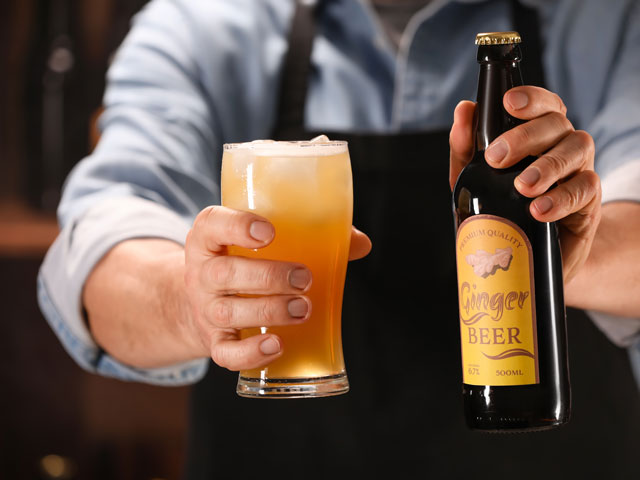What Is Ginger Beer & What Can You Do With It?
If you've been partaking in the consumption of adult beverages for some time, you probably know that ginger beer is a star ingredient in many popular mixed drinks, including crowd-pleasers like the Dark n' Stormy and the classic Moscow Mule.
Written by CraftJack | Updated | 7 min read
Interesting Tools
- Beer BrüMate Hopsulator
- Brewing Northern Brewer Beer Making Kit
- Spirit Crystal Whiskey Glasses
- Wine Wine Decanter/Aerator

What you may not know is how this pungent potable is made, what gives it its signature bite, and why it came to occupy such an essential place in the Who's Who of specialty cocktail components.
That's about to change. Here's everything you could ever hope to learn about ginger beer, distilled into a few snappy paragraphs to help it go down easy.
What Is Ginger Beer?
Ginger beer is a type of non-alcoholic beverage that uses (you guessed it) ginger as its primary flavoring.
Originally, ginger beer was made by brewing freshly-dug ginger root with water, cane sugar, and yeast and allowing the mixture to ferment for several weeks. The fermentation process gave rise to natural carbonation and a small amount of alcohol—hence the "beer" part of the name.
Ginger beer is no longer considered an alcoholic beverage despite its intoxicating provenance - at least in its most common incarnations. These days, its official classification is as a soft drink (meaning zero alcohol content), which explains why you may have spied six-packs of the stuff alongside the sarsaparillas and Mexican Cokes at your local supermarket.
Mass-market varieties of ginger beer contain very little—if any—alcohol (less than 0.5% by volume on average in cases where the byproducts of fermentation are retained). That's because they're no longer fermented. They're also not brewed anymore, as a rule. Instead, the core ingredients are simply blended together and artificially carbonated during manufacturing.
The result is a supremely sippable concoction that's similar in taste and body to its mellower cousin, ginger ale - which, by the way, almost always contains zero real ginger.
Regardless of its evolution, the drink's core character and widespread appeal have remained constant over the ages. Modern ginger beer still has all the qualities that made it such a hit upon its inception more than 300 years ago. It packs a pleasant sweetness, just the right amount of fizz, and a feisty afterburn that makes for one heck of a mix-in or chaser.
History of Ginger Beer
The first historical references to ginger beer appear in documents describing life in the British colonies around the turn of the 18th century. At that time, the British empire claimed dominion over roughly one-quarter of the known world, including far-flung regions of East Asia and the Caribbean.
Like so many other famous creations, ginger beer was a product of its environment.
Combining ginger, one of the newfound fruits of the Crown's flourishing Oriental spice trade, with the raw cane sugar that grew so abundantly in its equatorial outposts, the masterminds behind the first batch of ginger beer cooked up a tantalizing tonic. It was uniquely transnational and, at the same time, distinctly European. In the process, they gave birth to a sensational new brew style, the popularity of which would endure for centuries.
Since its debut in the early 1700s, ginger beer has gained a firm foothold in the soft drink market. It has gone on to become a favorite of both booze enthusiasts and teetotalers the world over.
Ginger Beer vs. Ginger Ale
If you've been following along up to this point, you may be asking yourself what the difference is between ginger beer and ginger ale. Very astute question—both are sweetened, carbonated, and list ginger among their main ingredients. How exactly do the two beverages differ?
Not much, as it turns out. You might think of them as variations on a theme.
As mentioned, both drinks are made in more or less the same fashion. The bulk of the contrast lies in the flavor department. While ginger ale is a light, crisp soda spiked with faint hints of its namesake spice, ginger beer is a far more potent version of the same basic formula, with loads of tongue-tingling spice and cranked-up ginger flavor.
Ginger beer's boldness helps it stand out when paired with various liquors, which is precisely why it's a staple in so many drinks.
Lastly, depending on how it's brewed and bottled, ginger beer may have a somewhat thicker body and cloudier appearance than ginger ale, which is thin and transparent. This cloudiness is because ginger beer undergoes less extensive filtration. It's also usually darker in color than ginger ale for the same reason.

What Are the Best Brands of Ginger Beer?
Ask any dedicated ginger beer aficionado or discerning mixologist what their go-to brand is, and you're likely to receive a slew of wide-ranging answers. Everybody's got their preferences—strictly speaking, no one ginger beer is superior to another.
That said, some are undeniably better for drink-making purposes. The best of the bunch still rely on fresh ginger root and cane sugar to lay the foundation for their flavor and keep artificial additives and taste-altering preservatives like ascorbic acid to a minimum. Here are just a few worthy options:
- Fever-Tree Premium Ginger Beer
- Maine Root Ginger Brew
- Barritt's Original Ginger Beer
- Bundaberg Ginger Beer
- Reed's Extra Ginger Brew
- Rachel's Ginger Beer
For example, the alcohol content for a brand like Barritt's Ginger Beer is zero.
What Drinks Can You Make With Ginger Beer?
Here are just a few drinks made with ginger beer. For a more comprehensive list, check out our Ginger Beer Cocktail List.
- Moscow Mule – The quintessential ginger beer cocktail. This iconic drink consists of vodka, ginger beer, and fresh-squeezed lime juice, all stirred together and garnished with a lime wedge. Moscow Mules are traditionally served in copper mugs, which help to keep them colder longer. A variant drink is the Old Fashioned Moscow Mule.
- Dark 'n' Stormy – A Dark and Stormy is one part dark rum (the "dark") and one part ginger beer (the "stormy"), plus ice and a lime wedge. Simple syrup and lime juice are occasionally added for extra sweetness and/or tang. Far less frightening than it sounds.
- Whiskey Ginger – The makings of this timeless are right there in the name. While conventional Whiskey Ginger recipes call for ginger ale, substituting ginger beer is an excellent way to give this simple yet satisfying pairing more of a kick.
There are also countless twists on classic drinks that incorporate ginger beer as an aromatic enhancer. For example, some unorthodox hooch hounds have been known to use ginger beer to jazz up faithful standbys like mojitos, margaritas, Mai Tais, and other beach drinks. It also frequently finds its way into the so-called "national drink" of Bermuda, the Rum Swizzle.
And, want to make a Mexican Mule? Leave the lemon juice at home and grab a beer stein (after all, this is a brewery-driven website), and pour in tequila, Cointreau, lime juice, and some of the best ginger beer you can buy. You can even buy some on Amazon.
What you can't buy on Amazon is Crabbie's Alcoholic Ginger Beer. Yes, not all Ginger Beer is non-alcoholic.

Benefits of Ginger Beer
Here in the West, we're accustomed to thinking of ginger mostly as a culinary ingredient. In many other cultures, however, the spice has long possessed a reputation as a medicinal supplement.
People have prized ginger for its health-promoting effects in Southeast Asia for over 2,000 years. There the locals believe that fresh ginger root provides the following benefits:
- Improved digestion
- Relief from nausea, stomach aches, and other gastrointestinal distress
- More efficient circulation
- Reduction in inflammation
- Decreased blood sugar levels
And the list doesn't stop there. One can safely assume that the myriad benefits of ginger naturally extend to its liquid form, which typically contains ample amounts of the spice's salubrious essence. When looked at from a wellness point of view, the universal pre-drink benediction "to your health" takes on a whole new meaning.
Is Ginger a Root?
While people often think of and refer to it as a root, natural ginger is technically a vegetable. It's the rhizome of the Zingiber officinale plant.
A rhizome is a type of bulbous stem that grows horizontally underground and stores starches and other nutrients necessary for the survival of the parent plant. Zingiber officinale rhizomes also hold large quantities of a botanical compound called "gingerols," which gives ginger bulbs the zesty, piquant flavor for which they're known.
Ginger as a Yeast Starter
Homebrew buffs sometimes wonder whether it's possible to whip up their own alcoholic ginger beer at home. The answer is a resounding "yes"—and it's remarkably easy to do so.
It all starts with "ginger bug," a type of starter culture commonly used to make naturally fermented beverages like kombucha, herbal sodas, and probiotic lemonade.
To get ginger bug going from scratch, simply combine one ounce of fresh diced or grated ginger and two teaspoons of sugar (a raw, organic sweetener like cane sugar or turbinado will work best) in two cups of filtered water. Let the mixture steep for five to seven days, each day stirring in an additional teaspoon of sugar and fresh ginger to feed the growing yeast.
Once your homemade bug begins bubbling consistently, it will be time to add your other ingredients (in this case, more water, sugar, and ginger) and let the fermenting fun commence.
If you're ever interested in starting a ginger beer plant, let us know.
Can you drink Ginger Beer straight?
What, like a whiskey neat? Jokes aside, yes, you can drink Ginger Beer straight. We sometimes prefer ours with a hint of lime.
Wrapping Up
There you have it, a shot of ginger beer history with a practical application chaser.
Hopefully, the knowledge you've gleaned here will give you a new appreciation for this lively brew the next time you encounter it in a cocktail or come across it at the grocery store.
We understand completely if that time happens to be later today. Cheers!
